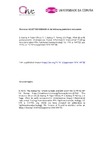Mostrar o rexistro simple do ítem
How do early socioeconomic circumstances impact inflammatory trajectories? Findings from Generation XXI
| dc.contributor.author | Soares, Sara | |
| dc.contributor.author | López-Cheda, Ana | |
| dc.contributor.author | Santos, Ana Cristina | |
| dc.contributor.author | Barros, Henrique | |
| dc.contributor.author | Fraga, Sílvia | |
| dc.date.accessioned | 2023-12-26T09:33:33Z | |
| dc.date.available | 2023-12-26T09:33:33Z | |
| dc.date.issued | 2020-09 | |
| dc.identifier.citation | S. Soares, A. López-Cheda, A. C. Santos, H. Barros, y S. Fraga, «How do early socioeconomic circumstances impact inflammatory trajectories? Findings from Generation XXI», Psychoneuroendocrinology, vol. 119, p. 104755, sep. 2020, doi: 10.1016/j.psyneuen.2020.104755. | es_ES |
| dc.identifier.issn | 0306-4530 | |
| dc.identifier.uri | http://hdl.handle.net/2183/34622 | |
| dc.description | © 2020. This manuscript version is made available under the CC-BY-NC-ND 4.0 license https://creativecommons.org/licenses/by-nc-nd/4.0/. This version of the article [S. Soares, A. López-Cheda, A. C. Santos, H. Barros, y S. Fraga, «How do early socioeconomic circumstances impact inflammatory trajectories? Findings from Generation XXI», Psychoneuroendocrinology, vol. 119, p. 104755, sep. 2020] has been accepted for publication in Psychoneuroendocrinology. The Version of Record is available online at https://doi.org/10.1016/j.psyneuen.2020.104755. | es_ES |
| dc.description.abstract | [Abstract]: Background: The association between socioeconomic position and markers of inflammation in adults, including C-reactive protein (CRP), is well-established. We hypothesized that children from families of less-advantaged socioeconomic circumstances may be at higher inflammatory risk during childhood and, consequently, throughout their life course. Thus, we aimed to investigate whether early socioeconomic circumstances impact CRP trajectories using repeated measures of data from a population-based birth cohort. Methods: Data from 2510 participants of Generation XXI, a prospective Portuguese population-based birth cohort, were included in this study. Early socioeconomic circumstances comprised maternal education and occupation, paternal education and occupation, and household income at the child’s birth. Venous blood samples were collected from the children at ages four, seven, and ten years, and high-sensitivity CRP (Hs-CRP) was quantified. Hs-CRP trajectories were computed using a linear mixed-model approach. Results: Participants from less-advantaged socioeconomic circumstances presented higher levels of Hs-CRP by age of ten years. The higher the mother´s education and disposable household income, the lower the minimum value of the log Hs-CRP observed throughout childhood. Further, the age at which that minimum log Hs-CRP value was reached occurs later, meaning that children born in more-advantaged socioeconomic circumstances had lower levels of log Hs-CRP compared with children from less-advantaged families. Conclusions: Poor socioeconomic circumstances early in life are associated with increased inflammation levels throughout the first decade of life. This study demonstrates that social inequalities may impact population health beginning at very early ages. | es_ES |
| dc.description.sponsorship | This work was supported by the European Regional Development Fund through the Operational Programme Competitiveness and Internationalization and national funding from the Foundation for Science and Technology (FCT), Portuguese Ministry of Science, Technology, and Higher Education under the projects “BioAdversity: How childhood social adversity shapes health: The biology of social adversity” (POCI-01- 0145-FEDER-016838; reference FCT PTDC/DTP-EPI/1687/2014), “HIneC: When do health inequalities start? Understanding the impact of childhood social adversity on health trajectories from birth to early adolescence” (POCI-01-0145-FEDER-029567; reference: FCT PTDC/SAU-PUB/29,567/2017). It is also supported by the Unidade de Investigação em Epidemiologia–Instituto de Saúde Pública da Universidade do Porto (EPIUnit) (reference UIDB/04750/2020), Administração Regional de Saúde Norte (Regional Department of Ministry of Health) and Fundação Calouste Gulbenkian; PhD grant SFRH/BD/108742/2015 (to SS) co-funded by FCT and the Human Capital Operational Programme (POCH/FSE Program); FCT Investigator contracts CEECIND/01516/2017 (to SF) and IF/01060/2015 (to ACS); and BEATRIZ GALINDO JUNIOR Spanish Grant (code BEAGAL18/00143) from MICINN (Ministerio de Ciencia, Innovación y Universidades), reference BGP18/00154 (to ALC). This study is also a result of the project DOCnet (NORTE-01-0145-FEDER-000003), supported by the Norte Portugal Regional Operational Programme (NORTE 2020), under the PORTUGAL 2020 Partnership Agreement. | es_ES |
| dc.description.sponsorship | Portugal. Ministério da Ciência, Tecnologia e Ensino Superior; FCT PTDC/DTP-EPI/1687/2014 | es_ES |
| dc.description.sponsorship | Portugal. Ministério da Ciência, Tecnologia e Ensino Superior; FCT PTDC/SAU-PUB/29,567/2017 | es_ES |
| dc.description.sponsorship | Universidade do Porto; UIDB/04750/2020 | es_ES |
| dc.language.iso | eng | es_ES |
| dc.publisher | Elsevier | es_ES |
| dc.relation.uri | https://doi.org/10.1016/j.psyneuen.2020.104755 | es_ES |
| dc.rights | Atribución-NoComercial-SinDerivadas 3.0 España | es_ES |
| dc.rights.uri | http://creativecommons.org/licenses/by-nc-nd/3.0/es/ | * |
| dc.subject | Socioeconomic circumstances | es_ES |
| dc.subject | C-Reactive protein | es_ES |
| dc.subject | Childhood | es_ES |
| dc.subject | Trajectories | es_ES |
| dc.title | How do early socioeconomic circumstances impact inflammatory trajectories? Findings from Generation XXI | es_ES |
| dc.type | info:eu-repo/semantics/article | es_ES |
| dc.rights.access | info:eu-repo/semantics/openAccess | es_ES |
| UDC.journalTitle | Psychoneuroendocrinology | es_ES |
| UDC.volume | 119 | es_ES |
| UDC.startPage | 104755 | es_ES |
Ficheiros no ítem
Este ítem aparece na(s) seguinte(s) colección(s)
-
GI-MODES - Artigos [141]






